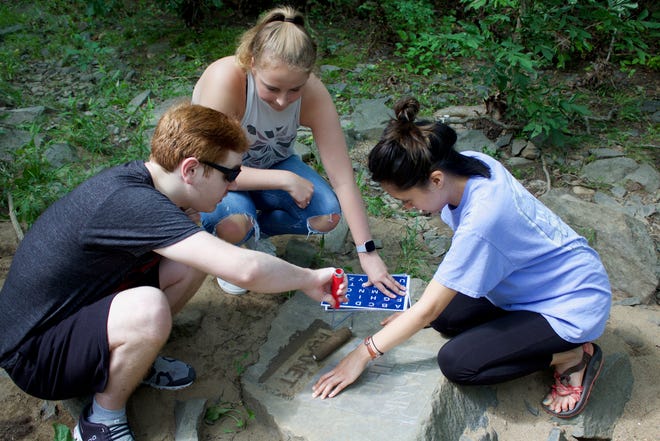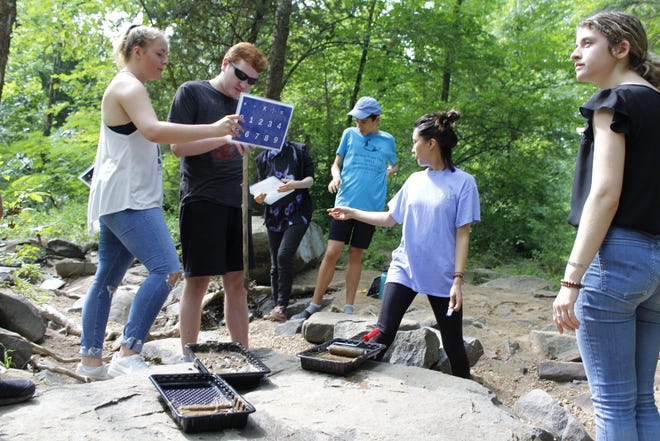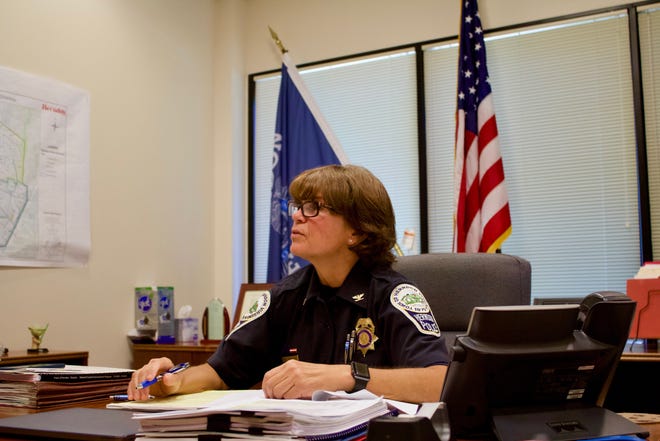HERNDON, Va. – On a humid morning this past summer, three college-age boys walked to their local river to make mud together for an eco-friendly art project.
Mixing dirt and water using sticks, and pushing a paint roller back and forth in the slimy liquid, they practiced a skill they want to improve: movement. By filling in stencils, the boys transformed their motions into communication, even though they weren’t speaking.
Turning physical movements into speech can be an obstacle for people with autism and sensory disorders. These conditions affect coordination and make it hard to perform learned motions – even ones as seemingly small as the movements people need to speak.
Alternative communication methods such as spelling have become everyday aspects of life for students at Growing Kids Therapy Center in suburban Washington, D.C.
“Our population of nonspeaking, unreliably speaking and minimally speaking individuals has at its core a motor-sensory difference,” said Elizabeth Vosseller, executive director of Virginia’s Growing Kids Therapy Center.

“Your mouth is like a limb. Your oral system is like an appendage,” said Dr. Connie Kasari, a UCLA professor in the center for autism research and treatment. “If you’re not very coordinated, it’s going to affect how well you can produce movement, speech being one of those movements.”
Growing Kids Therapy Center’s “spell-to-communicate” method is unique because it incorporates movement into nonspeaking communication. Atlanta and South Africa are also hubs for so-called spellers.
Despite its successes among some students, the spelling method needs to go through more testing, Kasari said. Plus, physically spelling words doesn’t work for all nonspeaking people.
“We’re looking for more options because there’s so much heterogeneity in autism,” Kasari said.
The students at Growing Kids fully comprehend conversations going on around them, even though they can’t respond via talking, Vosseller said.
Think of it this way, Vosseller said. “If I were to lose my voice and go to full-blown laryngitis, I’m not losing my ability to comprehend, I’m losing my ability to articulate.”
Using boards that display the alphabet – or even just common stencils – students at the center spell out words instead of saying them. That simultaneously helps students work on motor skills, Vosseller says, through physically reaching out, pointing, and touching the board in front of them.
“Practice doesn’t make perfect; practice makes permanent,” she said.
Activities like the eco-graffiti art also help students – whose ages have ranged from 5 to 54 – practice movement.

Money, time, and finding the appropriate research team have meant testing the spell-to-communicate method is an ongoing process, Vosseller said.
“We have a growing body of researchers who are looking into this,” Vosseller said. “It takes a while for someone to be interested in researching it.”
Using movement as therapy has led to positive results for people with other types of physical differences, though.
“We’re all movement experts because we all have to navigate our world through physical action,” said professional dancer David Leventhal, who runs Dance for PD, a New York organization that uses dance to help people with Parkinson’s regain control of their bodies.
“People with particular challenges are even more of experts because they have to problem-solve all the time,” he said. “Embodied conscious movement is just a different way of communicating.”
“As motor skills improve, communication improves,” Vosseller said. “It allows them to be part of the conversation instead of the subject of the conversation.”
In part because of their newfound access to communication, students from Growing Kids Therapy Center have become advocates for people with autism in Northern Virginia.
When he was 15 years old, Ian Nordling was almost arrested by police officers while living in Mercer Island, Washington. In a joint interview with his mother, Ian, now 21, said he caused a disturbance by walking in the street when he couldn’t follow instructions in the way the officers directed.
“If my dad had not shown up when he did, the outcome would surely have been different,” Ian said, sitting next to his mom, Rosaleen Presley.
“It likely was a result of a lack of education on the police officer’s part,” Herndon Police Chief Maggie DeBoard said of Ian’s incident with officers in Washington state.

Now, Ian is educating police officers at DeBoard’s station, helping them understand how they should interact with people who have autism and other special needs.
“I want people to know how hard it is for autistics to control themselves,” Ian wrote in an email. “Sometimes it is like we are autism’s puppet, and no matter how competent we are, autism won’t let our brains take control. Without having autism, it may be hard to make sense of. But I do hope people can get a better understanding and show compassion and respect to all autistics.”
DeBoard said she’s grateful for Ian’s willingness to get more involved with the police department in Herndon after having a bad experience elsewhere.
“He opened up a lot of people’s eyes,” she said. “The officers that I deal with here – and anywhere I’ve ever worked – want to do the right thing. They want to interact in the proper way. They just don’t always know how to do it.”
At the station, Ian made a pamphlet guide with tips for how officers can identify and interact with a person who has autism.
DeBoard said all the pamphlets were gone within a few days, and officers keep them handy during their daily work.
Through Ian, Herndon police officers now know to look for cues indicating a person might not be able to communicate verbally and might have sensitivities to touch, noise and light. Those could include acting overwhelmed and running away from officers.
Now, the Herndon Police Department is set to implement a special-needs registry, so officers can be aware of the varied needs of people living in the area they serve. That way, if there’s an emergency involving a person with autism or another difference, the police can know how to communicate appropriately.

